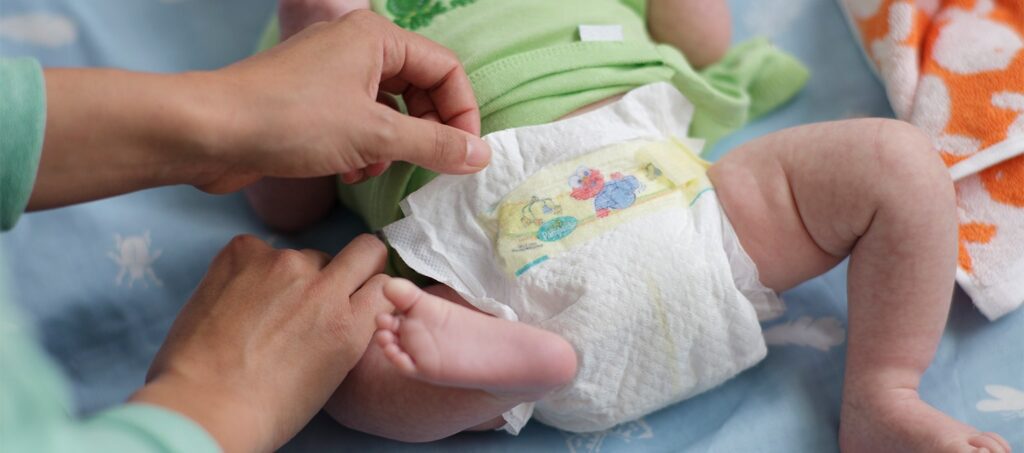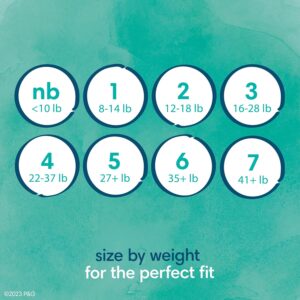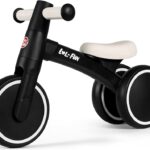Newborn diapers should be changed every 2–3 hours or when wet or soiled. Overnight, you can extend this time if the baby sleeps and the diaper can handle it.
Caring for a newborn brings many joys and challenges, one of which is mastering the art of diapering. As parents navigate the early weeks of their newborn’s life, they’ll quickly realise the importance of regular diaper changes to prevent rashes and maintain hygiene.
A newborn’s delicate skin is susceptible to irritation, making frequent diaper checks a critical part of daily care. With babies typically going through 10–12 diapers a day, a good supply is essential. New parents will learn how often to change newborn diapers, from fussiness to specific sounds or smells, ensuring their little one stays happy and comfortable. Remember, a clean diaper means a contented baby, setting the tone for a healthier, happier infancy.
Introduction To Newborn Diapering
Welcome to the world of newborn care, where mastering the art of diapering is a pivotal skill for every new parent. Adapting to your baby’s needs, especially regarding diaper changes, is crucial. An infant’s comfort and health significantly depend on a clean and dry bottom, setting the stage for a happy and serene environment. Let’s explore this tender aspect of parenthood together!
Understanding The Importance Of Regular Diaper Changes
Keeping your newborn dry and comfortable isn’t just about avoiding leaks; it’s about ensuring optimal skin health and preventing the dreaded diaper rash. A newborn’s skin is delicate, and exposure to wetness for extended periods can lead to irritation. Regularly changing diapers also means you’re constantly assessing your baby’s output, a valuable indicator of their well-being. Consistent diaper checks become a part of your routine, offering peace of mind that your baby is hydrated and their digestive system is functioning properly.
Initial Expectations For New Parents
Stepping into parenthood brings a steep learning curve, and understanding how often to change a newborn’s diaper is right at its heart. You can anticipate changing diapers up to 12 times a day for the first few weeks. This frequency often catches new parents off-guard, but it’s entirely routine for infants at this stage.
- Newborns urinate frequently. Their small bladders fill quickly, necessitating frequent checks and changes.
- Expect frequent bowel movements: The first days after birth, your baby will pass meconium, evolving into more regular bowel movements as they begin feeding.
- Overnight changes: You’ll need to change diapers during the night to ensure your little one stays clean and can sleep peacefully.
It’s worth noting that each baby is unique, and as you get to know your newborn, you’ll develop a sense of their specific needs and rhythms.
Recognising When It’s Time For A Change
New parents quickly learn that keeping their newborn comfortable and healthy includes maintaining a strict diaper-changing schedule. Recognizing when it’s time for a change is crucial for preventing diaper rash and ensuring your baby remains happy and hygienic. Here’s how to stay on top of this significant duty.
Identifying A Soiled Diaper: Visual And Olfactory Clues
One of the first skills parents develop is the ability to identify a soiled diaper. Visual cues such as a noticeable bulge or a change in the diaper’s color and shape often indicate fullness. Some diapers feature a wetness indicator line that changes color when wet.
Olfactory clues are equally telling. A strong ammonia scent is a clear signal that a urine change is due, while the unmistakable odour of a bowel movement means it’s time for a fresh diaper. Trust your senses; they will rarely steer you wrong.
Frequency Of Bowel Movements And Urination In Newborns
| Age | Bowel Movements | Urination |
|---|---|---|
| 0-1 Month | 3-4 times/day | 4-6 times/day |
| 1-3 Months | 2-3 times/day | 4-6 times/day |
While some variation is normal, newborns typically need a diaper change with each bowel movement and frequent changes after urination, potentially every one to three hours or 6–10 diapers a day. Maintain a log if necessary to monitor their patterns and ensure healthy habits.
Comfort And Hygiene: Preventing Diaper Rash And Discomfort
- Stay proactive with changes—don’t wait for discomfort signals from your baby.
- Clean the diaper area gently but thoroughly to avoid rashes and infections.
- Use a barrier cream or ointment to provide a protective layer on your baby’s skin.
- Ensure the diaper fits well but isn’t too tight; it should be snug without leaving marks.
- Give your newborn some “diaper-free time,” allowing their skin to breathe and reducing the risk of rash.
Adherence to these practices doesn’t just keep your newborn dry and comfortable. It also plays an integral part in their overall care and well-being.
Best Practices For Changing Newborn Diapers
Best Practices for Changing Newborn Diapers are essential for maintaining your little one’s health and comfort. Whether you’re a first-time parent or a seasoned carer, mastering the diaper-changing routine is a skill that contributes greatly to your newborn’s well-being. Let’s dive into the specifics of diaper changing frequency, gentle cleaning techniques, and choosing the right diaper to keep your baby clean, dry, and happy.
Recommended Diaper Change Frequency: Day Vs. Night
Understanding how often to change a newborn’s diaper is crucial for preventing discomfort and diaper rash. During the day, it is recommended to change your baby’s diaper every two to three hours, or immediately after every bowel movement. At night, the frequency can be reduced as long as your baby is not soiled or excessively wet. Aim for a diaper change right before bedtime and potentially once during the night, especially with younger newborns who may feed and soil diapers more often.
Gentle Cleaning Techniques For Newborns’ Sensitive Skin
When changing diapers, it’s important to use gentle cleaning techniques to protect your newborn’s delicate skin. Always have clean diapers, soft clothes or wipes, and a bottle of warm water at hand. Follow these steps for a safe and soothing cleaning experience:
- Use Soft Cloths or Wipes: Choose unscented, alcohol-free wipes to avoid irritation, or opt for a soft, damp cloth.
- Warm Water: A small bottle of warm water can be used to gently cleanse the area. This is especially helpful for cleaning off meconium, the sticky first stools of your newborn.
- Prompt and Thorough: Clean the diaper area efficiently to minimise discomfort, making sure to pat (not rub) the skin dry.
- Diaper Cream: Applying a diaper cream can create a barrier to protect against moisture and irritants.
Choosing The Right Diaper: Size, Material, And Brand Considerations
Selecting the appropriate diaper is as significant as changing frequency and cleaning techniques. It ensures comfort, prevents leaks, and avoids skin irritation. Consider the following when choosing diapers:
| Factor | Detail |
|---|---|
| Size | Choose a size that fits snugly without causing marks or chafing. Diapers typically come with weight ranges to guide you. |
| Material | Opt for breathable materials that allow air circulation and keep moisture away from the skin. |
| Brand Preferences | Some brands are known for their absorbency, others for organic materials. Decide which features are most important for your baby’s needs and comfort. |
Pay close attention to your baby’s reactions to different diaper brands and materials. Red marks, fussiness, or increased instances of diaper rash may signal that it’s time to try a different type.
Dealing With Common Challenges
Embarking on the journey of parenthood brings a myriad of new experiences and challenges, particularly when it comes to diaper duty for your newborn. As cute and cuddly as these little bundles of joy can be, they don’t shy away from creating some messy and testing situations. Dealing with common challenges during diaper changes is a part of every new parent’s life. Whether it’s dealing with a wriggly baby or finding a spot for a quick change in public, mastering the art of diaper changing is essential. Arm yourself with these insider tips to tackle some of the most common diaper-changing hurdles with ease.
Managing Diaper Changes For A Fussy Baby
Confronted with a squirmy infant, diaper changes can feel like wrestling an octopus. Keep your baby calm and collected during changes with the following strategies:
- Distract and soothe: Use toys, songs, or even your voice to distract your baby. A mobile above the changing table works wonders.
- Stay gentle but firm: Gentle touches reassure your baby, while a firm hold prevents them from turning the situation into playtime.
- Speed is your friend. The quicker the change, the less time there is for fuss. Prepare everything you need beforehand to speed up the process.
Navigating Diaper Changes In Public Places
Changing diapers while out and about can be a nerve-wracking experience. Consider this advice for smooth diaper changes on the go:
- Scout locations in advance: Know the layout of the places you visit often and identify potential changing spots.
- Portable changing pad: A clean, comfortable surface is vital for public diaper changes. Always carry a portable changing pad in your diaper bag.
- Wipes and hand sanitizer: These essentials are your best friends for cleanliness and hygiene, especially with no access to water.
Tips For Efficient Diaper Changing Stations At Home
Create a seamless diaper-changing experience at home with the following tips:
- Have multiple stations: One in the nursery and one in a common area reduces the need to rush to a single spot.
- Stock up: Ensure each station has diapers, wipes, creams, and a change of clothes.
- Use organizers: Caddies, drawers, or shelves can all help keep your supplies within reach.
- Invest in a quality-changing table. Comfort for the baby and back-friendly height for the parent make changes easier.
Advanced Diapering Tips And Tricks
Embarking on the parenting journey requires finesse in numerous areas, not least of which is mastering the art of diapering. With babies dictating their schedules, parents must evolve and adapt with advanced diapering tips and tricks that can make this messy challenge a seamless aspect of daily life. Let’s dive into some innovative approaches that redefine diaper changes for the modern parent.
Innovative Products For Modern Diapering
Today’s market offers a suite of innovative products designed to streamline diapering. Consider the Smart Diaper, a revolutionary technology that alerts parents to wetness levels, ensuring timely changes and optimal comfort for the newborn. For those nocturnal changes, look into high-quality, gentle lighting that soothes rather than startles your sleeping baby. Additionally, innovative changing pads with wipe-clean surfaces and built-in scale features can be game-changers in how you approach each diaper routine.
Incorporating Diapering Into Routine Baby Care
To maintain a well-structured day, incorporating diapering into the baby’s routine care is essential. Timely diaper changes align with feeding, playing, and sleeping times to create a predictable pattern that can soothe and comfort your infant. For instance, changing the diaper before each feeding can lead to a more content feeding session, while a diaper change right before bedtime can prevent middle-of-the-night disturbances due to discomfort. Remember that consistency fosters security for your newborn, making routines a core pillar of effective parenting.
Environmental Considerations: Cloth Vs. Disposable Diapers
Environmental impact is a critical topic in the realm of diapering, with a growing debate between using cloth versus disposable diapers. Cloth diapers represent a reusable, eco-friendly option that has come a long way in terms of convenience with snap or Velcro closures and improved leak protection. On the flip side, disposable diapers offer unmatched convenience, but at an environmental cost. To strike a balance, some parents opt for biodegradable disposables or use a combination approach, relying on cloth diapers when at home and disposables when on the go. The key is to consider your lifestyle and values when choosing the diapering method that works best for your family and the planet.
Conclusion: Embracing The Diapering Journey
As we wrap up our discussion on the often-asked question of how frequently to change a newborn’s diaper, it’s important to reflect on the overall diapering journey. This experience is more than just routine care; it’s a nurturing process that forms an integral part of bonding with your baby. The diapering stage, while sometimes challenging, is a period filled with growth, learning, and plenty of loving moments. Let’s revisit the essential points of what we’ve learned and offer some encouragement and resources for the road ahead.
Summarising Key Takeaways
- Expect to change your newborn’s diaper approximately 10 to 12 times a day.
- Change diapers promptly when wet or soiled to prevent diaper rash and discomfort.
- Overnight, it’s okay to allow a little more time between changes if the diaper is only wet and the baby is sleeping soundly.
- Choose the right diaper size and type for your baby to ensure maximum comfort and protection.
Encouragement For New Parents
Welcome to the new chapter of parenthood! Remember, each diaper change is more than a task; it’s a moment of connection with your little one. It may seem daunting now, but like most aspects of parenting, it becomes more natural with time. Trust your instincts, and don’t hesitate to lean on your support system when you need a break. You’ve got this, and your baby appreciates all the love and comfort you provide with each gentle touch and caring change.

Resources For Ongoing Support
Finding reliable information and support can make all the difference as you navigate the early stages of parenting. Below are some resources for ongoing support:
- Pediatricians: Always a great first stop for personalized advice about your baby’s health and well-being.
- Parenting Groups: Local and online communities offer the opportunity to connect with other parents who can share their experiences and tips.
- Parenting Apps: Many apps offer trackers and reminders for feeding and diaper changes, helping you stay on top of your baby’s needs.
- Books and Blogs: Look for ones that focus on newborn care for comprehensive guides on what to expect.
These tools and outlets will provide you with additional support and knowledge, ensuring that while this journey may have its challenges, you’re never alone in it.
Frequently Asked Questions On How Often To Change Newborn Diaper
How Often Should You Change Your Newborn Diaper?
Newborns typically require a diaper change every 2-3 hours or immediately after a bowel movement to prevent rashes and discomfort.
Is it OK to not change the newborn diaper at night?
It’s generally best to change a newborn’s diaper at night if it’s soiled or very wet to prevent diaper rash and discomfort.
Should I change the newborn diaper after feeding?
Yes, change your newborn’s diaper after feeding if it’s wet or soiled to ensure comfort and prevent rashes.
Should I Change A Poopy Diaper If Baby Is Sleeping?
Yes, change a sleeping baby’s poopy diaper to prevent discomfort and potential rash. Quick, gentle changes minimize disturbance.
How Often Should Newborns Be Diaper Changed?
Newborns typically need a diaper change every 2-3 hours, or whenever the diaper is soiled.
Can You Overchange A Newborn Diaper?
Overcharging isn’t generally a concern, but excessive changes could lead to diaper rash from constant friction.
Conclusion
Understanding your newborn’s needs is crucial, especially when it comes to diaper changes. Balancing comfort and hygiene helps prevent rashes and ensures your little one stays happy. Regular changes, roughly every two to three hours, are the norm, but always be responsive to cues for immediate attention.
Stay attentive, and you’ll soon become adept at maintaining your baby’s comfort and health.








